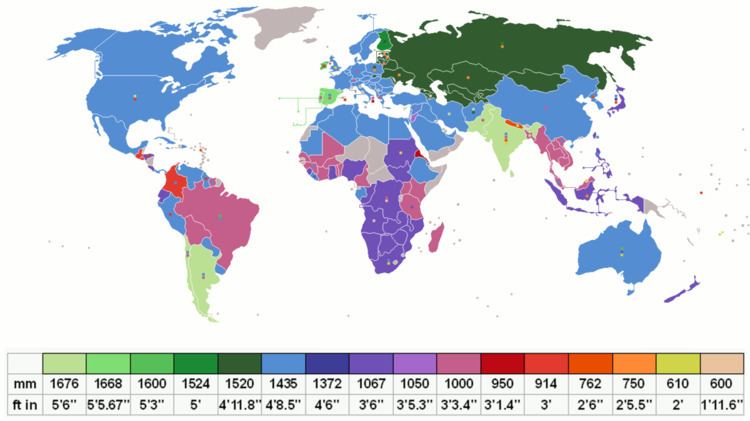Railways with a track gauge of 3 ft 6 in/1,067 mm were first constructed as horse-drawn wagonways. From the mid-nineteenth century, the 3 ft 6 in gauge became widespread in the British Empire, and was adopted as a standard in Japan.
There are approximately 112,000 kilometres (70,000 mi) of 1,067 mm gauge track in the world.
1795One of the first railways to use
3 ft 6 in (
1,067 mm) gauge was the
Little Eaton Gangway in
England, constructed as a horse-drawn
wagonway in 1795. Other
3 ft 6 in gauge wagonways in England and Wales were also built in the early nineteenth century.
1862In 1862 the Norwegian engineer
Carl Abraham Pihl constructed the first
3 ft 6 in gauge railway in
Norway, the
Røros Line.
1865In 1865 the
Queensland Railways were constructed. Its
3 ft 6 in gauge was promoted by the Irish engineer
Abraham Fitzgibbon and consulting engineer Charles Fox.
1868In 1868 Charles Fox asks civil engineer
Edmund Wragge to survey a
3 ft 6 in railway in
Costa Rica.
1871In 1871 the Canadian
Toronto, Grey and Bruce Railway and the
Toronto and Nipissing Railway were opened, promoted by Pihl and Fitzgibbon and surveyed by Wragge as an engineer of Fox.
1872In January 1872 Robert Fairlie advocated the use of
3 ft 6 in gauge in his book
Railways Or No Railways: Narrow Gauge, Economy with Efficiency v. Broad Gauge, Costliness with Extravagance.1872 also saw the opening of the first
3 ft 6 in gauge railway in
Japan, proposed by the British civil engineer Edmund Morel based on his experience of building railways in
New Zealand.
1873On 1 January 1873, the first
3 ft 6 in gauge railway was opened in
New Zealand, constructed by the British firm John Brogden and Sons. Earlier built
4 ft 8 1⁄2 in (
1,435 mm) and broad gauge railways were soon converted to the narrower gauge.Also in 1873 the
Cape Colony adopted the
3 ft 6 in gauge. After conducting several studies in southern
Europe, the
Molteno Government selected the gauge as being the most economically suited for traversing steep mountain ranges. Beginning in 1873, under supervision of Railway engineer of the Colony William Brounger, the
Cape Government Railways rapidly expanded and the gauge became the standard for southern Africa.
1876Natal also converted its short 10 kilometres (6.2 miles) long Durban network from
4 ft 8 1⁄2 in (
1,435 mm) broad gauge prior to commencing with construction of a network across the entire colony in 1876. Other new railways in Southern Africa, notably
Mozambique, Bechuanaland, the Rhodesias, Nyasaland and
Angola, were also constructed in
3 ft 6 in gauge during that time.
After 1876In the late nineteenth and early twentieth century numerous
3 ft 6 in gauge
tram systems were built in the
United Kingdom and the
Netherlands.
In Sweden, the gauge was nicknamed Blekinge gauge, as most of the railways in the province of Blekinge had this gauge.
An alternate name for this gauge, Cape gauge, is named after the Cape Colony in what is now South Africa, which adopted it in 1873. The term Cape Gauge is used in other languages, such as the Dutch kaapspoor, German Kapspur, Norwegian kappspor and French voie cape. After metrication in the 1960s, the gauge was referred to in official South African Railways publications as 1065 mm instead of 1067 mm.
The gauge is sometimes referred to as CAP gauge, after C.A. Pihl.
The gauge name Colonial Gauge was used in New Zealand.
In Australia the imperial (pre-metric) term 3 foot 6 inch is used. In some Australian publications the term medium gauge is also used, while in Australian states where 4 ft 8 1⁄2 in (1,435 mm) is the norm, 1,067 mm (3 ft 6 in) gauge is often referred to as narrow gauge.
In Japan 1,067 mm (3 ft 6 in) gauge is referred to as kyōki (狭軌), which directly translates as narrow gauge. It is defined in metric units.
Similar rail gauges in respect of aspects such as cost of construction, practical minimum radius curves and the maximum physical dimensions of rolling stock are:
1,100 mm (3 ft 7 5⁄16 in),1,093 mm (3 ft 7 in),1,055 mm (3 ft 5 1⁄2 in),1,050 mm (3 ft 5 11⁄32 in), and1,000 mm (3 ft 3 3⁄8 in) metre gauge. 
